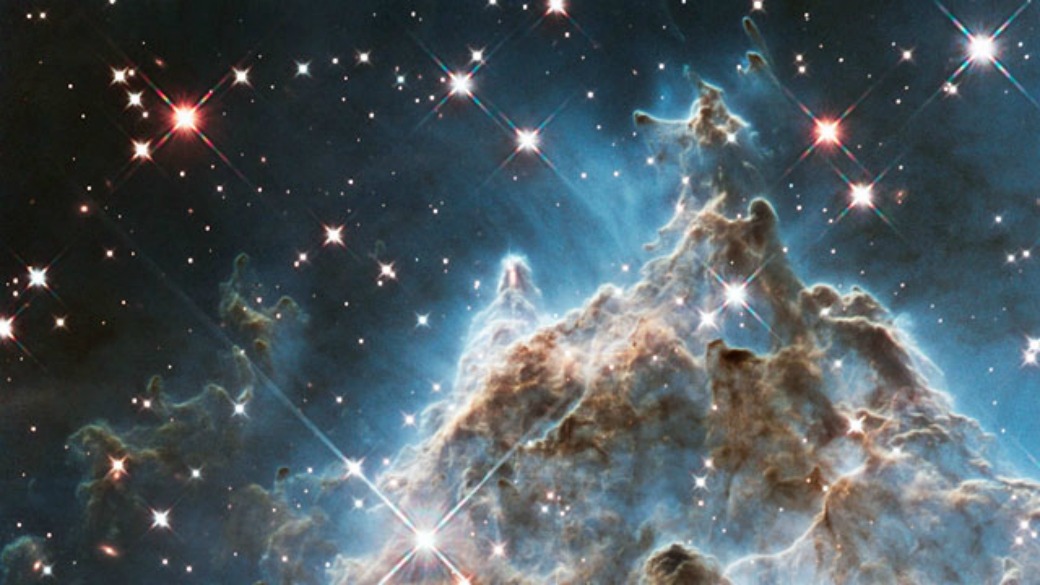You may have noticed that The Greatest Kid On The Planet and I are fascinated by the moon and the stars and anything immeasurable. It’s no surprise The Greatest Kid loves Astronomy, and this week was an exciting one. In school, he and his classmates talked about the Hubble Space Telescope which was launched into space in 1990 and is still circling the earth today. At home together, we watched a fascinating documentary about this amazing technology and the extraordinary discoveries that have been made, and it prompted some compelling conversation and reflection.
The Eagle Nebula is approximately 6,500 light-years from earth. In case you’re wondering, just one light-year is 9.5 trillion kilometers. According to NASA, even if we hitched a ride on the space shuttle, it would take approximately 37,000 years to cover the distance of just one light-year. So, in other words, we’re not going to the Eagle Nebula any time soon. This nebula, which is made up of dust and gas, is so far-reaching that the pillars which it has formed are, in themselves, as much as four light-years tall.
The pillars that make up the nebula are dotted with tiny clumps of gas which look like bumps. Inside of these bumps, or EGGs (Evaporating Gaseous Globules, as astronomers call them) stars are developing. In the incredible images the Hubble telescope captured, these EGGs look very tiny in comparison to the rest of the nebula. But, in reality, the EGGs, themselves, are so vast that our entire solar system could fit inside just one.
It’s boggling to the mind.
In 1995, researchers decided to turn Hubble toward what was considered an “empty” part of the sky, and over the course of ten days, they took a series of images to see what was there. What they discovered in this one small section of empty space was a dense field of galaxies, thousands of them, dotting the universe like brilliant fireflies, and each one of these galaxies contains billions of stars.
Astronomers estimate there are hundreds of billions of galaxies in the universe, but that, of course, is only a guess. How can you put a number on something that is endless?
The concept of endless is something The Greatest Kid and I ponder often. We sit in awe and listen to these things that we can’t possibly comprehend. As hard as we try, there is no way to put it into perspective. The magnitude of what is out there is so breathtaking, it’s almost too wrenching to wrap our minds around.
The Greatest Kid says learning about the universe and all that never ends makes him feel small. We are, after all, barely a speck on a speck on a speck, hardly worthy of even Horton and the Whos. It’s easy to understand why he would feel insignificant in comparison when faced with the knowledge of something so much greater.
Contemplating the vastness of all that is around us should, indeed, make us consider certain aspects of our lives, how small our troubles are in comparison, how insignificant the things we sometimes concern ourselves with, the everyday details we allow to preoccupy our minds and take up space in our heads.
But I think it should also remind us of the magnitude of our lives.
It’s easy to get caught up in the day-to-day. And often it takes some event of considerable proportions to shake us out of the cloud we live in and remind us how big our life is.
One of my all-time favorite movies, Joe Versus The Volcano, illustrates this in a resonant way. Unfortunate events involving a boat and a bad storm leave Joe Banks and Patricia Graynamore stranded in the middle of the Pacific Ocean. After days of surviving the hot sun with little food or water, Joe awakens one night to the sight of a super moon rising in front of him. He struggles to his feet, dwarfed by the magnificence of the brilliant sphere, and thanks God for his life. And then he says, “I forgot how big.”
I’ve watched Joe take on the volcano a countless number of times, and that scene gets me every time.
Do we forget how big our life is?
If we could walk around each day with that same sense of wonder, with the realization of the magnitude of our lives on the very surface of our consciousness, what would we do differently? Would we waste a single day? A single moment?
According to astronomers, there are billions of stars in the universe, too many to count. The lifespan of just one star is millions of years before it goes supernova and explodes and fades away. In the entire scope of the universe, one hundred years doesn’t even compare. But for us, one hundred years is a lifetime.
My father says almost the whole world’s asleep. Everybody you know, everybody you see, everybody you talk to. He says only a few people are awake. And they live in a state of constant, total amazement.
If we were aware at every moment of how fleeting it all is, would we see our lives differently? Would we change the way we’re living?
Would we stop making excuses?
Would we refuse to stay stuck?
Would we start taking chances and stop taking our days for granted?
Astronomers believe that in five billion years, our sun will run out of fuel. And when it does, it will expand into a giant red star and destroy the earth and our entire solar system with it. There will be nothing left, and what was once our sun and our moon and our stars will be nothing more than a splash of color, visible from thousands of light-years away.
Whether you believe in the Big Bang or that our world was created by design, there is no arguing it’s worthy of unprecedented awe and wonder. No other planet that we know of comes even close. It’s almost impossible to conceive the extraordinary equation which added up to the sum of all we’re surrounded by and all that we see. And the billions of years it took to create it.
So, if we could grasp it with any clarity, and feel the enormity of our mere one hundred years, and what it means just to be here, then shouldn’t we be living our lives in the same way?
What would it mean to be the best version of ourselves? The one we only dream of being?
Would we stop being afraid to try? To fail? To feel? To fly?
What would it take to get to the end of our days and not wish we had done things differently?
One day, in billions of years, the universe will continue on without us. If one hundred years is what we get, what are we doing with it? It’s a simple question, without a simple answer. But here is a little perspective…
The sun still has five billion years, and it doesn’t waste a minute.
M.C. Greene
(This extraordinary image of the Eagle Nebula, situated a distance of 6,500 light-years from planet Earth, was captured by the Hubble Space Telescope.)


